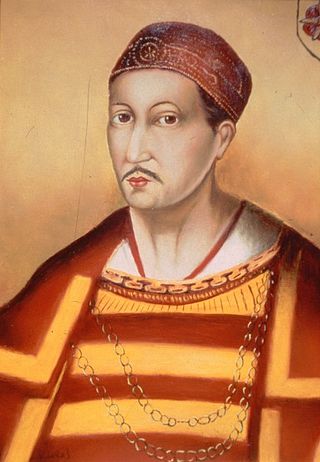
Adolf was the count of Nassau from about 1276 and the elected king of Germany from 1292 until his deposition by the prince-electors in 1298. He was never crowned by the pope, which would have secured him the imperial title. He was the first physically and mentally healthy ruler of the Holy Roman Empire ever to be deposed without a papal excommunication. Adolf died shortly afterwards in the Battle of Göllheim fighting against his successor Albert of Habsburg.

The County of Mark was a county and state of the Holy Roman Empire in the Lower Rhenish–Westphalian Circle. It lay on both sides of the Ruhr River along the Volme and Lenne rivers.

Count Engelbert II of Berg, also known as Saint Engelbert, Engelbert of Cologne, Engelbert I, Archbishop of Cologne or Engelbert I of Berg, Archbishop of Cologne was archbishop of Cologne and a saint; he was notoriously murdered by a member of his own family.
Henry II "the Rich" of Nassau, German: Heinrich II. "der Reiche" von Nassau was Count of Nassau. He distinguished himself in particular by his chivalrous and devout spirit. He was charitable and made great donations to the church, so that the monasteries and prayer houses in the area of present-day Nassau experienced the most significant bloom in his time. The greatest favour was the Teutonic Order to enjoy, to which he donated especially for the renunciation of his brother's, upon his entry into the order. Henry participated in the Sixth Crusade. He was the builder of the castles Sonnenberg, Ginsburg and Dillenburg.
Otto II, a member of the Ezzonid dynasty, was Count Palatine of Lotharingia from 1034 until 1045 and Duke of Swabia from 1045 until his death.

Adolf I, Count de la Mark, until 1226 also known as Adolf I, Count of Altena-Mark. He was son of Frederick I, Count of Berg-Altena and Alveradis of Krickenbeck, daughter of Reiner of Krieckenbeck-Millendonk.

The House of La Marck was an ancient German noble family, which from about 1200 appeared as the Counts of Mark.

The House of Limburg-Stirum, which adopted its name in the 12th century from the immediate county of Limburg an der Lenne in what is now Germany, is one of the oldest families in Europe. It is the eldest and only surviving branch of the House of Berg, which was among the most powerful dynasties in the region of the lower Rhine during the Middle Ages. Some historians link them to an even older dynasty, the Ezzonen, going back to the 9th century.
Herman II, Lord of Lippe was a ruling Lord of Lippe.
Engelbert II of the Mark was Count of the Mark and through marriage, Count of Arenberg.
William IV, Count of Jülich was the son and heir of William III of Jülich and Mathilde of Limburg, daughter of Waleran III, Duke of Limburg.
Adolf VIII of Berg was the eldest son of Count Adolf VII of Berg and Margaret of Hochstaden.

Count John I of Nassau-Siegen, German: Johann I. Graf von Nassau-Siegen, was since 1362 Count of Nassau-Siegen. He descended from the Ottonian Line of the House of Nassau.
Eberhard I was a German nobleman. He was Count of the Mark from 1277 until his death. He was the son of Engelbert I, Count of the Mark and Kunigunde of Blieskastel, daughter of Count Henry I of Blieskastel.

Bernard VII of Lippe was the ruler of the Lordship of Lippe from 1429 until his death. Because of the many bloody feuds in which he was involved, he was nicknamed "the Bellicose". He is the longest-ever ruling European monarch.

Otto III of Ravensberg was Count of Ravensberg from 1249 until his death.
Henry IV, Count of Waldeck was the ruling Count of Waldeck from 1305 to 1344. He was the second ruling count named "Henry", which is why some authors call him "Henry II". However, two earlier non-ruling members of the House of Waldeck are usually called Henry II and Henry III, and the subject of this article is commonly called Henry IV.

The house of Limburg Hohenlimburg took its name in the 12th century from the county of Limburg on the river Lenne in today's Germany. After Diederick of Isenberg had claimed part of the former property of his father Frederik of Isenberg with the help of uncle Duke Hendrik of Limburg, he built the Hohenlimburg castle on the river Lenne. At fifty years of age, his third son Everhart, closest descendant of the original holder, succeeded him in the county. Mentioned count, in original kept charters, since 1276 together with his father. It was clear that the future male-line primogeniture was granted. Everhard is the ancestor of the family branch of the counts of Limburg Hohenlimburg and Broich. His first brother Henry died young and second Johan (1247–1277), died at the age of thirty, left three children. Johan is the ancestor of the house Lords of Limburg Stirum. The Counts of Limburg Hohenlimburg and Broich were not count by name with a late 17th century certified title but actually ruled the county of Limburg-Lenne since the 13th century, until the first quarter of the 16th century. The last count Johan (1464–1511) who had no descendants of his own. None of his only two male relatives, cousins Diederick and Adolf of Limburg, sons of his former godfather Johan of Limburg (1421–1472), had inheritance rights, as explained below. To prevent the family of his former wife Von Neuenahr from taking the county, Count Johan adopted his cousin Irmgard of Sayn at her marriage to Winrich of Daun. She and her husband inherited the county.










